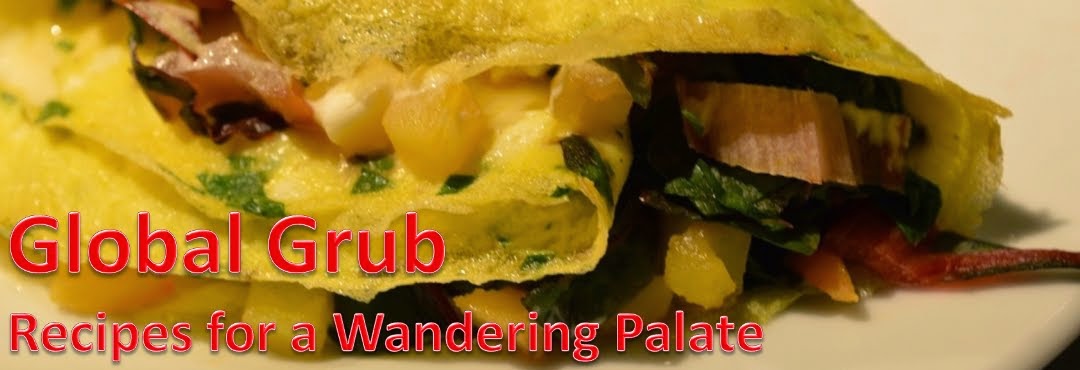This is a really interesting recipe for a lighter version of a seafood gumbo. Typically, the base of a gumbo is the roux - a mixture of equal parts of fat and flour, typically in unhealthy quantities. The idea is that you coat the starch molecules in fat and cook the heck out of them until they begin to develop more complex flavors, typically to the point that you end up with a nutty richness and deep brown, or 'chocolate' roux. This is a time consuming and irritating process, but it's been established as the basis for a lot of southern cooking, and I can't argue with centuries of successful (and large) southern ladies. So I was intrigued when I discovered that this was going to be a fat-free roux; only the flour was going to be browned, sans butter, which seemed somewhat confusing. In the end, this worked out great, although it was no less irritating to stir flour in a dry pan for 12 minutes so it wouldn't burn.
Gumbo is traditionally made with crawfish or shrimp, some kind of meat, and commonly with okra as a thickening agent. If you haven't worked with okra before, it's a bizarre, slimy pod that's delicious when prepared right, and obnoxious when it's just boiled and served to you in a big bowl. I used some flash-frozen okra from the restaurant supply store, but if you can get fresh, go for it. Another ingredient you might see is filé powder (sassafras leaves), but we're not going there today. As the vegetable base, as opposed to the standard mirepoix of carrots, celery, and onions seen in a lot of northern European and American cooking, the gumbo uses the Louisiana variant of the trinity, which consists of bell peppers, celery, and onions.
My recipe used shrimp and a flat fish filet, in this case swai. The recipe called for snapper, but I was tipped off to a snapper shortage at the grocery store, so I went with the closest looking fish. I don't think there would be a huge difference in the final flavor regardless, and at least having the fish filet with the shrimp was a nice combination of textures.
For the inquisitive, I looked into the origins of this dish, and discovered that the recipe presented here is probably some kind of bastardization between the Cajun and Creole gumbo recipes (http://en.wikipedia.org/wiki/Gumbo), based on the inclusion of tomato, okra, and celery all together. I don't really care which one it was - it was delicious, hearty, a little spicy, and satisfying.
Gulf of Mexico Gumbo
Cooking Light, June 1997
Yield: 9 servings (serving size: 1 cup gumbo and 1/2 cup rice)
Prep Time: 1.5 hours
- 1 cup all-purpose flour
- 1 teaspoon vegetable oil
- 2 cups chopped onion
- 1 cup chopped green bell pepper
- 1/2 cup chopped celery
- 4 garlic cloves, minced
- 1 cup sliced okra
- 1 cup chopped tomato
- 1 1/2 cups water
- 1/2 tbsp salt
- 1/2 tsp cayenne pepper
- 1/4 tsp garlic powder
- 1/4 tsp black pepper
- 4 (8-ounce) bottles clam juice
- 2 bay leaves
- 1/2 pound skinned red snapper or other firm white fish fillet, cut into 1-inch pieces
- 1/4 cup thinly sliced green onions
- 3/4 pound crayfish*, peeled (I used more shrimp)
- 1/4 pound medium shrimp, peeled and deveined
- 1/2 teaspoon hot sauce
- 4 1/2 cups hot cooked long-grain rice
*Note: One (8-ounce) container select oysters, undrained, can be substituted for crayfish, if desired.
Place flour in a 9-inch cast-iron skillet; cook over medium heat 20 minutes or until browned, stirring constantly with a whisk. (If flour browns too fast, remove it from heat, and stir until it cools down.) Remove from heat; set aside.
 |
| Go from this... |
Heat oil in a large Dutch oven over medium heat. Add onion, bell pepper, celery, and garlic; sauté 8 minutes or until vegetables are tender. Add okra and tomato; cover and cook 5 minutes, stirring occasionally. Add 1 1/2 cups water, salt, cayenne, garlic powder, black pepper, clam juice, and bay leaves, and bring to a boil. Gradually add browned flour, stirring with a whisk. Reduce heat; simmer, uncovered, for 45 minutes, stirring occasionally.
 |
| The okra. Slime not shown, but it's there, trust me. Those crazy Cajuns figured out how to use this slime as a thickener - way to find the silver lining. |
 |
| Here's the trinity - onions, celery, and bell peppers |
 |
| All of the vegetables, before adding in the liquids and roux |
 |
| The gumbo, pre-fish addition. It was thick immediately after adding the roux (browned flour). Bear in mind that you won't see the full thickening potential until the mix has come to a full boil. |
Add snapper; cook 5 minutes. Add green onions, crayfish, and shrimp; cook 10 minutes or until seafood is done. Stir in hot sauce; discard bay leaves. Serve gumbo over rice.
 |
| The swai filet, cut into bite-sized pieces for addition to the mix. |
 |
| The finished gumbo, with some bread I tried to make. The presentation impressed my guests. The flavor floored us all. |




















